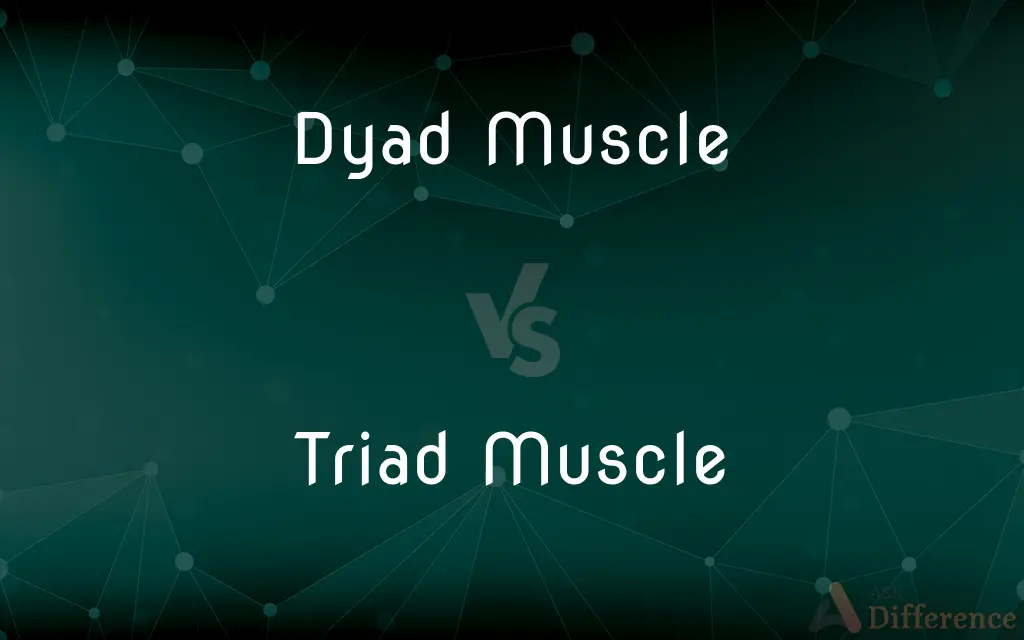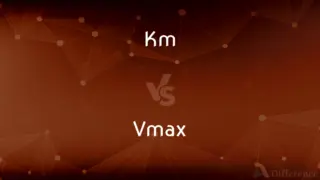Dyad Muscle vs. Triad Muscle — What's the Difference?
By Tayyaba Rehman & Urooj Arif — Published on February 17, 2024
Dyad muscle structures are found in cardiac muscle cells, featuring a T-tubule and a single terminal cisterna. Triad muscle structures are characteristic of skeletal muscle, consisting of a T-tubule flanked by two terminal cisternae.

Difference Between Dyad Muscle and Triad Muscle
Table of Contents
ADVERTISEMENT
Key Differences
The distinction between dyad and triad muscle structures lies in their cellular architecture and their role in muscle contraction. Dyad structures, predominantly found in cardiac muscle cells, consist of a transverse (T)-tubule paired with a single terminal cisterna of the sarcoplasmic reticulum. This configuration facilitates the rapid propagation of action potentials and the subsequent release of calcium ions necessary for cardiac muscle contraction. The dyad structure is specifically adapted to meet the continuous and rhythmic contraction needs of the heart, ensuring efficient cardiac output.
Triad structures, on the other hand, are a hallmark of skeletal muscle cells. Each triad consists of a T-tubule sandwiched between two terminal cisternae of the sarcoplasmic reticulum. This arrangement is crucial for the initiation and regulation of skeletal muscle contraction. Upon receiving a nerve impulse, the triad structure allows for a swift and coordinated release of calcium ions, triggering muscle fiber contraction. The dual cisternae provide a larger reservoir of calcium ions, which is essential for the powerful and sustained contractions required by skeletal muscles during voluntary movements.
The difference in structure between dyads and triads reflects the distinct functional requirements of cardiac and skeletal muscles. While the dyad arrangement in cardiac muscle supports its rhythmic and uninterrupted contractions, the triad configuration in skeletal muscle accommodates the need for rapid, forceful, and controlled contractions. This architectural distinction underscores the specialized roles these muscles play in the human body, tailored to their specific physiological demands.
In summary, dyad and triad muscle structures represent two specialized arrangements for calcium ion release and muscle contraction regulation. These structures are fine-tuned to the unique operational needs of cardiac and skeletal muscles, highlighting the complexity and specificity of muscle cell architecture in facilitating precise and effective muscle function.
Comparison Chart
Location
Cardiac muscle cells
Skeletal muscle cells
ADVERTISEMENT
Composition
One T-tubule and one terminal cisterna
One T-tubule flanked by two terminal cisternae
Function
Facilitates action potential propagation and calcium release for cardiac contraction
Ensures rapid and coordinated calcium release for skeletal muscle contraction
Physiological Role
Supports continuous and rhythmic heart contractions
Allows for forceful and controlled voluntary movements
Calcium Ion Reservoir
Single terminal cisterna provides calcium ions
Dual terminal cisternae offer a larger calcium ion source
Compare with Definitions
Dyad Muscle
Essential for cardiac muscle's rhythmic contraction.
Dyads ensure the heart contracts uniformly by facilitating synchronized calcium release.
Triad Muscle
Adapted for quick and sustained skeletal muscle activity.
The architecture of triads supports the dynamic needs of skeletal muscle function.
Dyad Muscle
Unique to cardiac muscle cell physiology.
Unlike skeletal muscles, cardiac muscles feature dyads for their contraction mechanism.
Triad Muscle
Enable precise control over muscle fiber contraction.
Triads facilitate the precise and controlled movements of voluntary muscles.
Dyad Muscle
Comprise a T-tubule and a single terminal cisterna.
The dyad's architecture is crucial for calcium ion release in cardiac muscle.
Triad Muscle
Consist of a T-tubule with two adjacent terminal cisternae.
The triad's dual cisternae significantly enhance calcium ion availability for contraction.
Dyad Muscle
Dyads are structures in cardiac muscle cells for contraction regulation.
Cardiac cells utilize dyad structures to efficiently manage continuous heartbeats.
Triad Muscle
Triads are found in skeletal muscle cells, aiding in contraction.
Skeletal muscles rely on triad structures for rapid and forceful contractions.
Dyad Muscle
Adapted for the heart's continuous operational demands.
Dyad structures in the heart are optimized for enduring rhythmic activity.
Triad Muscle
Provide a larger reservoir for calcium ions.
The dual terminal cisternae in triads serve as an extensive calcium ion source for contractions.
Common Curiosities
Can dyad and triad structures be found in the same muscle type?
No, dyads are specific to cardiac muscles, while triads are found in skeletal muscles.
What is a dyad in muscle cells?
A dyad is a structure in cardiac muscle cells consisting of a T-tubule and a single terminal cisterna.
Why do cardiac muscles have dyads instead of triads?
Dyads suit the continuous and rhythmic contraction needs of the heart, optimizing calcium release for cardiac function.
What is a triad in muscle cells?
A triad in muscle cells refers to a structure in skeletal muscle that includes a T-tubule flanked by two terminal cisternae.
How do triads facilitate skeletal muscle contraction?
Triads ensure a rapid and coordinated release of calcium ions, enabling forceful and controlled muscle contractions.
How does the structure of a triad enhance muscle contraction?
The presence of two terminal cisternae increases the calcium ion reservoir, enhancing the muscle's contraction capability.
Why are triads important for voluntary movement?
They provide the necessary architecture for quick, forceful, and precise control over skeletal muscle contractions.
Do dyads contribute to the heart's rhythmic beating?
Yes, they play a crucial role in regulating calcium release, essential for the heart's continuous rhythmic contractions.
What role do terminal cisternae play in muscle contraction?
Terminal cisternae store calcium ions, which are vital for initiating muscle contraction when released.
Is the presence of dyads and triads a universal feature across all muscles?
No, dyads are specific to cardiac muscle cells, while triads are characteristic of skeletal muscle cells.
Share Your Discovery

Previous Comparison
Km vs. Vmax
Next Comparison
Squalane vs. Hemi-SqualaneAuthor Spotlight
Written by
Tayyaba RehmanTayyaba Rehman is a distinguished writer, currently serving as a primary contributor to askdifference.com. As a researcher in semantics and etymology, Tayyaba's passion for the complexity of languages and their distinctions has found a perfect home on the platform. Tayyaba delves into the intricacies of language, distinguishing between commonly confused words and phrases, thereby providing clarity for readers worldwide.
Co-written by
Urooj ArifUrooj is a skilled content writer at Ask Difference, known for her exceptional ability to simplify complex topics into engaging and informative content. With a passion for research and a flair for clear, concise writing, she consistently delivers articles that resonate with our diverse audience.
















































